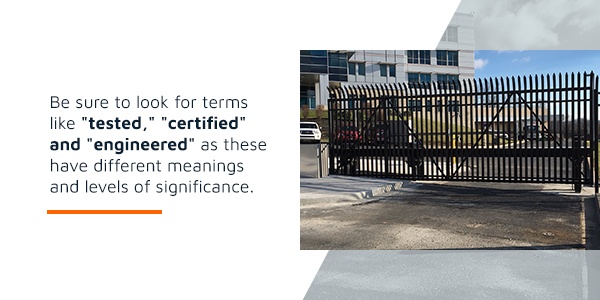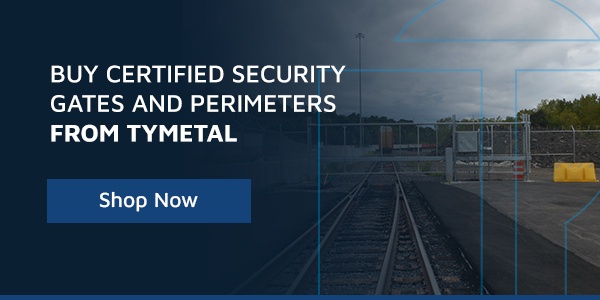Security gates and bollards play a crucial role in protecting entrances from unauthorized access and potential damage due to accidental collisions. These security measures are essential in modern industries and defense sectors. To ensure the effectiveness of such barriers, standardized and unbiased U.S. crash ratings are used to evaluate their durability. Understanding these ratings can help you choose the best barriers that can withstand impacts from vehicles. If you're looking for a secure gate or bollard, it's important to pay attention to crash ratings. This guide will explain how to interpret crash ratings for gates and bollards, helping you make informed decisions. Three main factors influence the results of crash tests: Some rating systems only certify up to a certain distance beyond the barrier. Any further penetration means the barrier hasn’t met certification standards. Together, these three elements define a barrier’s crash rating. You may come across terms like K-ratings and M-ratings, so understanding the differences between them is essential. K-ratings were introduced by the Department of Defense (DOD) in 1985. These ratings are based on how far a 15,000-pound vehicle travels past a barrier at a specific speed. A K-rating is only awarded if the vehicle travels 50 feet or less beyond the barrier. Higher K-numbers indicate higher test speeds using the same vehicle type and weight. Common K-ratings include: K-ratings are further divided into L1, L2, and L3 classifications based on how far the front of the vehicle traveled beyond the barrier: The strongest K-rated barrier would be K12:L3 — meaning a 15,000-pound vehicle moving at 50 mph penetrated the barrier less than 3 feet. When interpreting K-ratings, the “K†number represents the test speed, while the “L†number indicates how far the vehicle traveled beyond the barrier. M-ratings have largely replaced K-ratings in recent years, following guidelines from the American Society for Testing and Materials (ASTM). Unlike K-ratings, which focus on the front of the vehicle, M-ratings consider how far the vehicle’s payload travels beyond the barrier. They still rely on vehicle weight, speed, and travel distance. M-ratings are similar to K-ratings in that their numerical designations correspond with test speeds. For example, a K4 rating matches an M30 rating, K8 matches M40, and K12 matches M50. The vehicles in these tests traveled at 30, 40, and 50 mph, respectively. M-ratings and K-ratings are often interchangeable. M-ratings also use P1, P2, P3, and P4 classifications, based on how far the vehicle traveled beyond the barrier: M-ratings allow for greater distances than K-ratings, making them more accurate in some cases. An equivalent of K12:L3 would be M50:P1. Meanwhile, an M50:P2 rating could withstand a 15,000-pound vehicle at 50 mph without allowing it to travel more than 23 feet. It’s important to understand the distinctions between "tested," "certified," and "engineered" when evaluating crash-rated products. Here’s what each term means: When choosing a barrier, always prioritize "certified" M- or K-rated products. If you encounter "tested" or "engineered" labels, ask whether the tested product met the required standards or if the engineered product underwent physical testing. Without real-world validation, there’s no guarantee it will perform as expected in actual crashes. As mentioned earlier, ASTM uses specific models and codes to classify anti-ram tests based on vehicle speed, weight, and distance traveled. Being able to interpret these codes is essential for understanding crash ratings. Learn more about ASTM standards for vehicle security barrier crash tests. Speed ratings are designated as follows: Penetration ratings for low-speed tests include: For high-speed tests, the standards are slightly more flexible: When security is a top priority, you need barriers that meet the highest standards. At TYMETAL, all of our security gates and crash barriers have achieved prestigious ASTM crash ratings. You can trust that our products meet the universal and unbiased standards set by ASTM. Shop durable crash barriers and commercial gates from TYMETAL today. Reviewed By Chris Herold on 4/29/2021 Stainless Steel Cold Heading Wire Stainless Steel Cold Heading Wire,Stainless Steel Bright Wire,Stainless Annealed Wire,Stainless Steel Soft Binding Wire Jiangsu Manrui New Materials Co., Ltd , https://www.manruiwire.comA Comprehensive Guide to Understanding Crash Ratings

The Three Key Factors That Determine Crash Ratings
K-Ratings: The Traditional Standard
M-Ratings: The Modern Alternative
Tested vs. Certified vs. Engineered: What’s the Difference?

Understanding ASTM Models and Codes
Choose Certified Security Gates and Perimeters from TYMETAL
